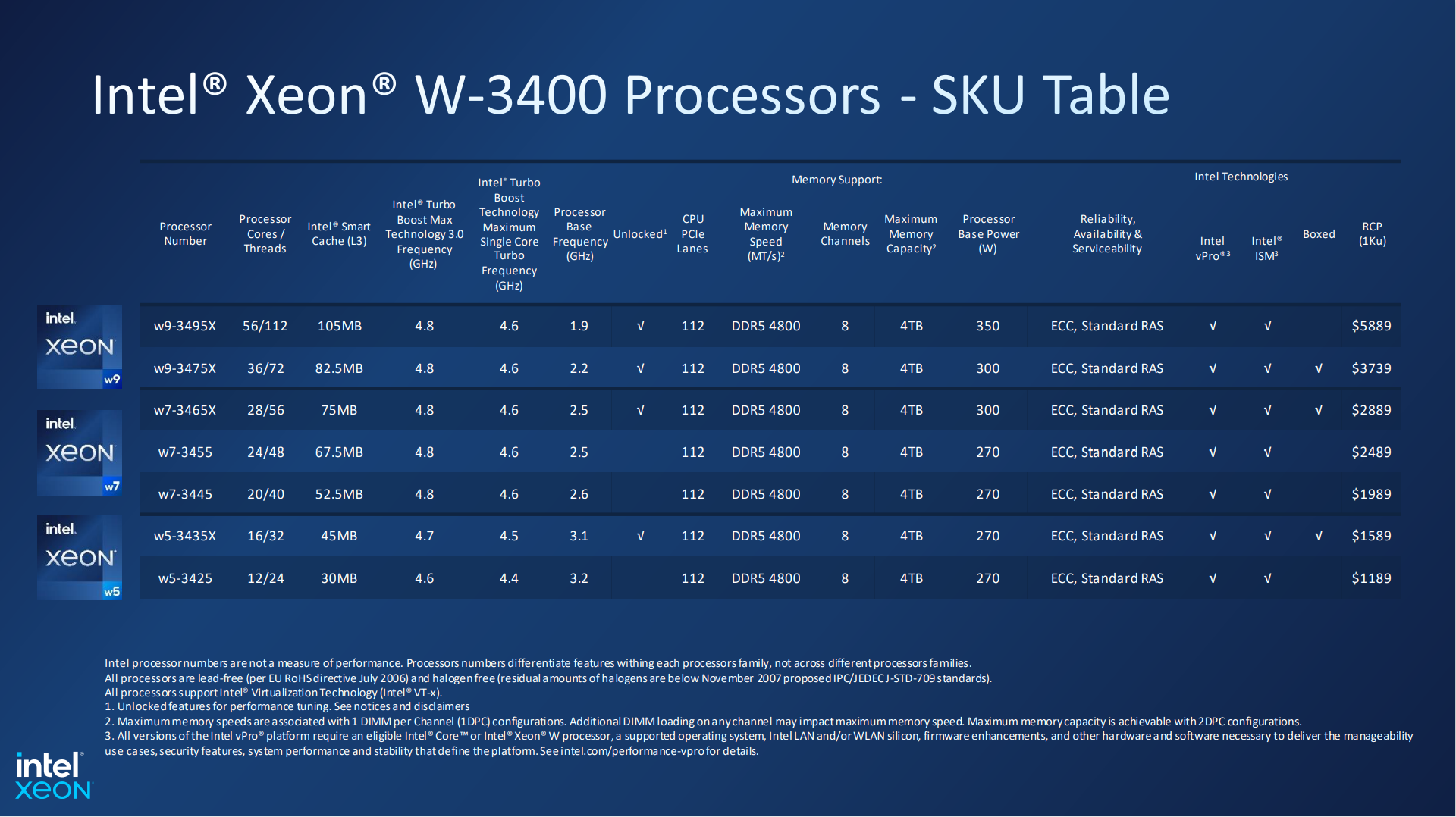Intel Launches Xeon W-3400 and W-2400 Workstation Processors

Sapphire Rapids Arrives
Intel announced their new desktop workstation processors yesterday, with the Xeon W-3400 and Xeon W-2400 series parts. The flagship is the Xeon w9-3495X, a 56-core, 112-thread monster that Intel calls their “most powerful desktop workstation processor ever designed”. These CPUs feature Intel’s Sapphire Rapids architecture, built with “new embedded multi-die interconnect bridge (EMIB) packaging”.
More than a compute upgrade, the overall platform for these new processors has been greatly improved compared to previous generations, with up to 112 PCIe 5.0 lanes (W-3400) and 8-channel DDR5 RDIMM support (up to 4 TB) among the standout features.
According to Intel, these new processors offer significant performance gains over Intel’s previous offerings, with claims of “up to 28% single thread and up to 120% multithread performance improvements over the previous generation” for their top Xeon w9-3495X part. The large 105 MB L3 cache and up to 4.8 GHz clocks help here.
Via Intel:
Why It Matters: Xeon W-3400 and Xeon W-2400 processors provide the high-end computing foundation that today’s professionals require for the future of computing. Support for DDR5 RDIMM memory, PCIe Gen 5.0 and Wi-Fi 6E give professionals the cutting-edge platform technologies they require for the compute workloads of the future. Additionally, support for Intel vPro Enterprise technology, alongside ECC memory and reliability, availability, and serviceability (RAS) technologies, ensure workstation uptime is maximized so professionals don’t have to worry about workflow interruptions.
What It Offers: Available with up to 56 cores in a single socket, the top-end Intel Xeon w9-3495X processor features a redesigned memory controller and larger L3 cache, delivering up to 28% single thread and up to 120% multithread performance improvements over the previous generation. And operational frequencies up to 4.8 gigahertz with Intel Turbo Boost Max Technology 3.0 provide professional users with incredible compute performance in daily workloads.
Other platform features include:
- Up to 105 megabytes of L3 cache for increased performance and data management.
- Eight channels of DDR5 RDIMM memory support enables up to 4 terabytes of memory capacity and increased memory bandwidth for large data sets and memory-intensive workloads.
- ECC memory and RAS technologies support improved integrity of critical data and system reliability.
- Up to 112 CPU PCIe Gen 5.0 lanes on Xeon W-3400 processors and up to 64 CPU PCIe Gen 5.0 lanes on Xeon W-2400 processors for multi-GPUs, SSDs and network cards give professionals configuration flexibility to meet their next task.
- Integrated Intel Wi-Fi 6E for the latest network connectivity.
- Comprehensive overclocking support for unlocked processors – including first-in-industry DDR5 XMP 3.0 RDIMM memory overclocking features.
- 3rd generation Intel Deep Learning Boost (AMX, Bfloat16) delivers significantly more efficient deep learning acceleration for artificial intelligence training and inferencing.
- Intel vPro enterprise technologies for hardware-enhanced security features, firmware version control and remote manageability enable easy system deployment into the enterprise
environment
The full lineup of Intel Xeon W-3400 processors includes SKUs from 12c/24t all the way up to the 56c/112t flagship, and pricing scales up as one might expect:
That $5889 price for the w9-3495X undercuts AMD’s highest-end Threadripper PRO, which sells at retail for $6499 (though of course we don’t know Intel’s retail price yet). AMD has the core count advantage at the high end (64 vs. 56), but Intel’s platform and performance improvements make for a rather compelling alternative in the professional workstation space.
But Intel didn’t just launch ultra high-end parts, of course, and the W-2400 series starts at just $359 for their 6c/12t Xeon w3-2423 part, ranging up to the 24c/48t Xeon w7-2495X at $2189:
As to availability, pre-orders from Intel’s industry partners began yesterday, with general system availability slated for March.













